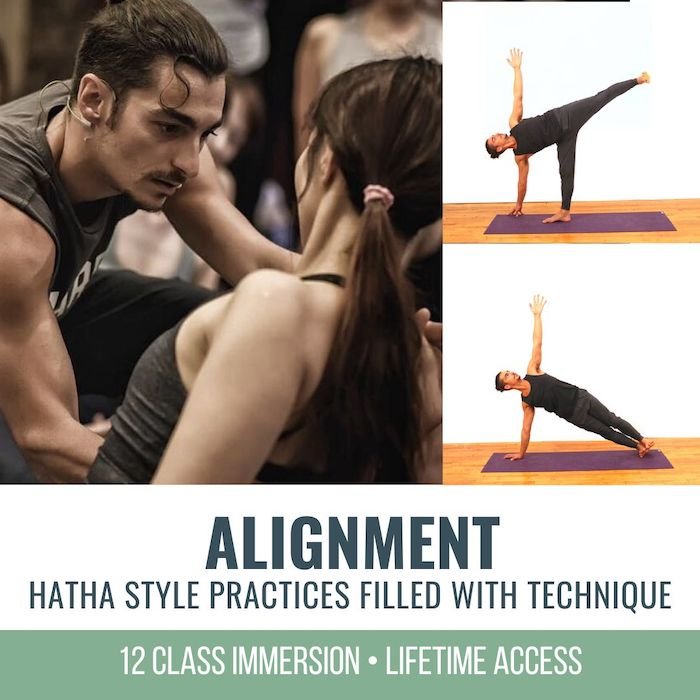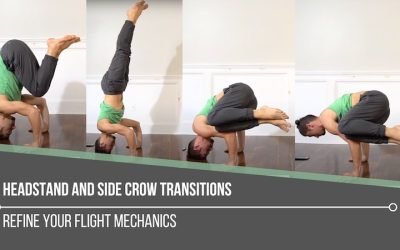Handstand ActionsLEAN, GRIP, PUSHHANDSTAND ACTIONS Handstand isn’t something we conquer in a single class, it’s a layered process that demands repetition and refinement. There are certain key handstand actions that are non-negotiable: lifting the shoulders up to the...
Plank, Chaturanga, Upward Dog
Plank, Chaturanga, Upward Dog
Shoulder Mechanics Simplified
ALIGNMENT
PLANK, CHATURANGA, UPWARD DOG
How many times have you heard the cue “Plank, Chaturanga, Upward Dog” in a yoga class? If you’re a regular practitioner, it’s probably quite often (particularly in Vinyasa-style classes). These postures are often strung together in a sequence, and the repetition of this sequence can feel quite nice in your body once it becomes a more regular part of your asana practice. It’s easy, however, to become complacent in the execution of these postures and potentially miss opportunities to practice with more skill. In today’s video, Matt simplifies the shoulder mechanics within each posture and highlights how to effectively utilize the appropriate muscle groups for maximum efficiency in your body. You’ll come away with alignment insights that will uplevel your yoga practice.
ALIGNMENT
JUNE 2023 Immersion
- 12 Hatha-style practices
- Transformative and informative experience
- Alignment and techniques for the most common asana postures
- Step-by-step, easy-to-follow instruction
- Improve strength, balance, flexibility, and proprioception
- Accessible and empowering modifications
- Appropriate variations a modifications for all levels
$168.00 $138.00
UNDERSTANDING PLANK
Plank is the foundation and start of the sequence of Plank, Chaturanga, Upward Dog. It is the start of being able to understand some of the common tendencies you may have when it comes to stability. Matt explains that one tendency is the anterior tilt of the scapulae (i.e., the shoulders roll forward). This is not necessarily wrong, but if your body regularly defaults into the pattern, it may be an indication that your serratus anterior is weak. It’s your serratus anterior that works to protract the scapulae (a requirement for Plank Pose). If this area is weak, then your pectoralis minor will attempt to take over. A big indicator here is a “sagging” between the shoulder blades. In Plank, your torso is being weighed down by gravity, so the pull of the chest, or “sagging,” is almost inevitable if the serratus anterior is weak.
WATCH THE VIDEO
PLANK, CHATURANGA, UPWARD DOG: SHOULDER MECHANICS SIMPLIFIED
CHATURANGA AND THE ROLE OF GRAVITY
In the full class, Matt discusses the importance of understanding the role of gravity and its influence on Plank and Chaturanga. In Plank, we now understand the tendency to close the distance between the shoulder blades. In Chaturanga, however, there is an element of going with gravity through the movement, while also opposing it. In other words, in Chaturanga, the shoulder mechanics change. You’re moving from protraction in Plank to retraction. This is where it gets tricky. Even though there is a level of retraction, it’s critical to note that the muscles that allow you to lower into Chaturanga slowly are the muscles that create protraction. There is still a level of effort placed on protraction so as not to just go with gravity and fall on your face. Essentially, you are fighting against gravity in order to maintain a slow stable descent into Chaturanga.
200 HOUR ONLINE TEACHER TRAINING
GET CERTIFIED & DEEPEN YOUR YOGA PRACTICE
- Deepen your yoga practice
- Build confidence speaking in front of groups in person and online
- Learn foundational class structures and templates
- Learn techniques for a wide range of yoga postures
- Get certified and highly qualified to teach yoga
- Yoga Alliance Globally Recognized Certification Program
UPWARD-FACING DOG
Falling into the same pattern of anterior tilt in the shoulders is very easy here too. Upward Dog has the capacity to be a strong backbend, but this is achieved by creating a posterior tilt of the scapulae. Instead of thinking about how to manipulate this action from the top of the shoulder blades, Matt suggests bringing your awareness to the bottom tips. Bringing the bottom tips of the scapulae in towards your midline while sending them forward will help to create the shape. Lifting your shoulders up while also sending them back will ultimately send your chest forward to create the backbend. If this proves to be challenging, it comes back to strengthening both the serratus anterior and, in this case, the lower trapezius, which can help you break away from old patterns. It’s the difference between dropping into gravity and lifting up and out with more power.
300 HOUR ONLINE TEACHER TRAINING
GET 500 HOUR CERTIFIED AS A MASTER TEACHER
Master your skill set as a teacher through refined techniques, anatomy, biomechanics, sequencing, philosophy, meditation techniques, theming, yoga business, and much more!
- Get 500 hour certified
- Learn anatomy, biomechanics, asana techniques
- Expand your teaching skills
- Masterful sequencing and verbal delivery
- Learn meditation and breathwork techniques
- Transformative tools: theming, dharma talks, satsang
TRANSITION
Plank, Chaturanga, Upward Dog—instead of just going through the motions, you now need a deeper sense of awareness in this sequence. Of course, your body will start to re-pattern, and there will be less thought once the pattern becomes ingrained in your body. The sequence of Plank, Chaturanga, Upward Dog will become more fluid, but until then, it will be a process of becoming more familiar with the timing of when to protract, retract, elevate, and depress your shoulders. In today’s video from Matt’s Alignment Immersion, he takes you on the journey of these 3 postures. If you’re interested in going even further, investing in his 200 & 300 hour training programs is the way forward. This is where you will go further into not only transforming your own practice but becoming certified to support and transform the practice of your students.
The 200 Hr. Teacher Training: Click Here to See the Next Start Date
The 300 Hr. Advanced Teacher Training: Click Here to See the Next Start Date
Article by Trish Curling
Video Extracted From: Alignment Immersion
Continue Learning
Handstand Actions
Handstand Mechanics
Handstand MechanicsINVERSIONHANDSTAND MECHANICS Stability, strength, and coordination come together in the pursuit of mastering handstand mechanics. One of the most critical foundations is internal rotation at the hip joints, which can aid with certain entries and...
Stable Sirsasana
Stable SirsasanaHEADSTANDSTABLE SIRSASANA Creating a stable Sirsasana is less about the final pose and more about the mechanics that lead us there. From weight transfer and spinal alignment to hamstring flexibility and shoulder engagement, each layer matters. Unlike...
Explore Hip Rotation
Explore Hip RotationSURYA YANTRASANAEXPLORE HIP ROTATION Hip rotation isn’t just an anatomical concept—it’s an open invitation to become more intimate with our body’s story. In yoga, we often live in lateral (external) rotation, especially in hip-opening postures....
Step Up Your Side Plank
Step Up Your Side PlankVASISTHASANASTEP UP YOUR SIDE PLANK Side Plank might look simple, but true proficiency starts in the details. One of the keys to refining the posture is learning how opposing muscle groups create an isometric contraction—a subtle engagement that...
Headstand and Side Crow Transitions
Headstand and Side Crow TransitionsPARSVA BAKASANAHEADSTAND AND SIDE CROW TRANSITIONS Mastery begins with mechanics, especially when it comes to headstand and side crow transitions. Each posture on its own demands control, coordination, and a deep understanding of...
THE FREE TECHNIQUE PACK
When You Subscribe, You Will Get Instant Access to
- the Technique Pack: 15 yoga pose breakdowns
- exclusive online course discounts
- exclusive blogs and videos












